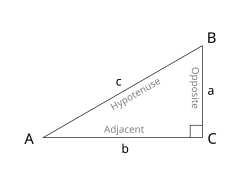Hi friends this my first blog.I will maintain interesting posts in it.kindly bear me.
In my first post i will introduce the trigonometric formulas and ratios which i know.
All of the
trigonometric functions of an angle
θ can be constructed geometrically in terms of a unit circle centered at
O.
| Trigonometry |
 |
|
|
|
|
|
|
|
|
|
|
|
|
Trigonometry (from
Greek trigōnon, "triangle" and
metron, "measure"
[1]) is a branch of
mathematics that studies relationships involving lengths and
angles of
triangles. The field emerged in the
Hellenistic world during the 3rd century BC from applications of
geometry to
astronomical studies.
[2]
The 3rd-century
astronomers first noted that the lengths of the sides of a
right-angle triangle and the
angles
between those sides have fixed relationships: that is, if at least the
length of one side and the value of one angle is known, then all other
angles and lengths can be determined algorithmically. These calculations
soon came to be defined as the
trigonometric functions and today are pervasive in both
pure and
applied mathematics: fundamental methods of analysis such as the
Fourier transform, for example, or the
wave equation, use trigonometric functions to understand
cyclical phenomena across many applications in fields as diverse as physics,
mechanical and
electrical engineering, music and acoustics, astronomy, ecology, and biology. Trigonometry is also the foundation of
surveying.
Trigonometry is most simply associated with
planar right-angle
triangles (each of which is a two-dimensional triangle with one angle
equal to 90 degrees). The applicability to non-right-angle triangles
exists, but, since any non-right-angle triangle (on a flat plane) can be
bisected to create two right-angle triangles, most problems can be
reduced to calculations on right-angle triangles. Thus the majority of
applications relate to right-angle triangles. One exception to this is
spherical trigonometry, the study of triangles on
spheres, surfaces of constant positive
curvature, in
elliptic geometry (a fundamental part of
astronomy and
navigation). Trigonometry on surfaces of negative curvature is part of
hyperbolic geometry.
Trigonometry basics are often taught in schools, either as a separate course or as a part of a
precalculus course.

In this right triangle: sin A = a/c; cos A = b/c; tan A = a/b.
If one
angle
of a triangle is 90 degrees and one of the other angles is known, the
third is thereby fixed, because the three angles of any triangle add up
to 180 degrees. The two acute angles therefore add up to 90 degrees:
they are
complementary angles. The
shape of a triangle is completely determined, except for
similarity, by the angles. Once the angles are known, the
ratios
of the sides are determined, regardless of the overall size of the
triangle. If the length of one of the sides is known, the other two are
determined. These ratios are given by the following
trigonometric functions of the known angle
A, where
a,
b and
c refer to the lengths of the sides in the accompanying figure:
- Sine function (sin), defined as the ratio of the side opposite the angle to the hypotenuse.
-

- Cosine function (cos), defined as the ratio of the adjacent leg to the hypotenuse.
-

- Tangent function (tan), defined as the ratio of the opposite leg to the adjacent leg.
-
- The hypotenuse is the side opposite to the 90 degree angle in a
right triangle; it is the longest side of the triangle and one of the
two sides adjacent to angle A. The adjacent leg is the other side that is adjacent to angle A. The opposite side is the side that is opposite to angle A. The terms perpendicular and base are sometimes used for the opposite and adjacent sides respectively.
Many people find it easy to remember what sides of the right triangle
are equal to sine, cosine, or tangent.
The reciprocals of these functions are named the cosecant (csc or cosec), secant (sec), and cotangent (cot), respectively:



-













